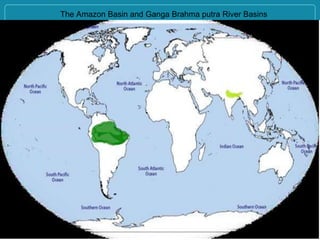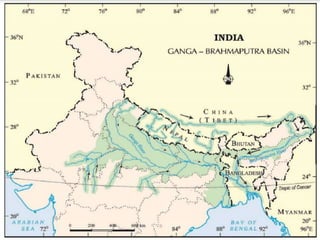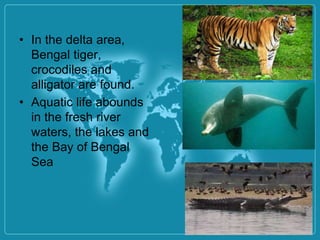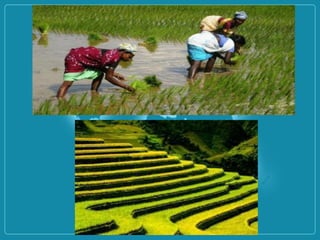Ch 8 Human Environment Interactions The Tropical the Subtropical Region 1.pptx
- 3. TOPIC HUMAN ENVIRONMENT INTERACTIONS THE TROPICAL AND THE SUBTROPICAL REGION
- 4. Introduction: • Human are occupying almost all parts of the world, The environment is playing an important role on the life of the people across the globe. • We will study this by taking two example from (1) Tropical region and (2) Sub Tropical region. • This comparative study shows how the human beings are adjusting as well as changing the environment according to their needs.
- 5. AMAZON BASIN • LOCATION Between 10°N and 10°S. So, it is referred to as the equatorial region • The river Amazon flows through this region. Notice how it flows from the mountains to the west and reaches the Atlantic Ocean to the east
- 6. The Amazon Basin and Ganga Brahma putra River Basins
- 7. The Amazon Basin in South America
- 8. CLIMATE • The Amazon Basin stretches directly on the equator and is characterized by hot and wet climate throughout the year. • It rains almost everyday. • The day temperatures are high with very high humidity. At night the temperature goes down but the humidity remains high.
- 9. NATURAL VEGETATION • It is the region of world’s largest rainforests. • The forests are in fact so thick that the dense “roof” created by leaves and branches does not allow the sunlight to reach the ground.
- 10. Amazon basin
- 11. Thick canopy formed by Amazpm forest
- 12. • The ground remains dark and damp. Only shade tolerant vegetation may grow here. Orchids, bromeliads grow as plant parasites
- 13. WILDLIFE • The rainforest is rich in fauna. Birds such as toucans, humming birds are found with distinct features. • Animals like monkeys, sloth and ant-eating tapirs are found here. • Various species of reptiles and snakes also thrive in these jungles. Crocodiles, snakes, pythons abound. Anaconda and boa constrictor are some of the species. • Besides, the basin is home to thousands of species of insects. • Several species of fishes including the flesh • Eating Piranha fish is also found in the river.
- 16. PEOPLE • People grow most of their food in small areas after clearing some trees in the forest. • They practice “slash and burn agriculture”. • The staple food is manioc, also known as cassava that grows under the ground like the potato.
- 17. DEVELOPMENT • The developmental activities are leading to the gradual destruction of the biologically diverse rainforests. • In the older days the heart of the forest, could be reached only by navigating the river. • In 1970 the Trans Amazon highway made all parts of the rainforest accessible. • Aircrafts and helicopters are also used for reaching various places.
- 19. GANGA BRAHMAPUTRA BASIN LOCATION: • The basin lies in the sub-tropical region that is situated between 10°N to 30°N latitudes. • The plains of the Ganga and the Brahmaputra, the mountains and the foothills of the Himalayas and the Sundarbans delta are the main features of this basin.
- 21. • CLIMATE • The area is dominated by monsoon climate. • The monsoon brings rains from mid-June to mid-September. The summers are hot and the winters cool.
- 22. NATURAL VEGETATION • In the Ganga and Brahmaputra plain tropical deciduous trees grow, along with teak, sal and peepal. • Thick bamboo groves are common in the Brahmaputra plain. Bamboo Groves in Brahmaputra plain
- 23. • The delta area is covered with the mangrove forests. • In parts of Uttarakhand, Sikkim and Arunachal Pradesh, coniferous trees like pine, deodar and fir can be seen because the climate is cool and the slopes are steep mangrove forests coniferous trees
- 24. WILDLIFE • There is a variety of wildlife in the basin. • Elephants, tigers, deer and monkeys are common. • The one-horned rhinoceros is found in the Brahmaputra plain.
- 25. • In the delta area, Bengal tiger, crocodiles and alligator are found. • Aquatic life abounds in the fresh river waters, the lakes and the Bay of Bengal Sea
- 26. PEOPLE • The density of population of the plains is very high. • Agriculture is the main occupation of the people where flat land is available to grow crops. • The main crop is paddy, Wheat, maize, Banana plantations and tea plantations.
- 28. DEVELOPMENT • The Ganga-Brahmaputra plain has several big towns and cities. • The wastewater from these towns and industries is discharged into the rivers. • All the four ways of transport are well developed in the Ganga-Brahmaputra basin. • Kolkata is an important port on the River Hooghly.
- 29. HUMAN INTERACTION IN GANGA BASIN
- 30. • Summary of Facts Learnt • Amazon is the world’s largest river system. It is the typical example of the rainforests. • High temperature and humidity is the characteristic of this region. • Shifting agriculture is practiced where the forests have been cleared. High trees, and wide variety of wild life both on territorial land and in water found in this region. • Gradual cleaning of forests and developmental activities leads to variety of environmental problems. • The Ganga-Brahmaputra basin is typical of the Subtropical climate. • The region is one of the most fertile part of the world. Population density is high. • Natural vegetation and animal life is very rich. The forest provide many forest products. • A number of tribes still inhabit the part of this region. • Again here also the developmental activities polluting the environment.
- 31. • DISCLAIMER • Images/information used in this presentation are collected from Diksha portal. • Heartly thanks for this site for these useful images. • This presentation is used for educational purpose only. • This presentation is purely used for non commercial purpose. • No images or photographes were altered or harmed in any manner in this presentation and have no intention to manipulate them in any man ner. • Thank you for the authors of Diksha portal.
- 32. THANK YOU































